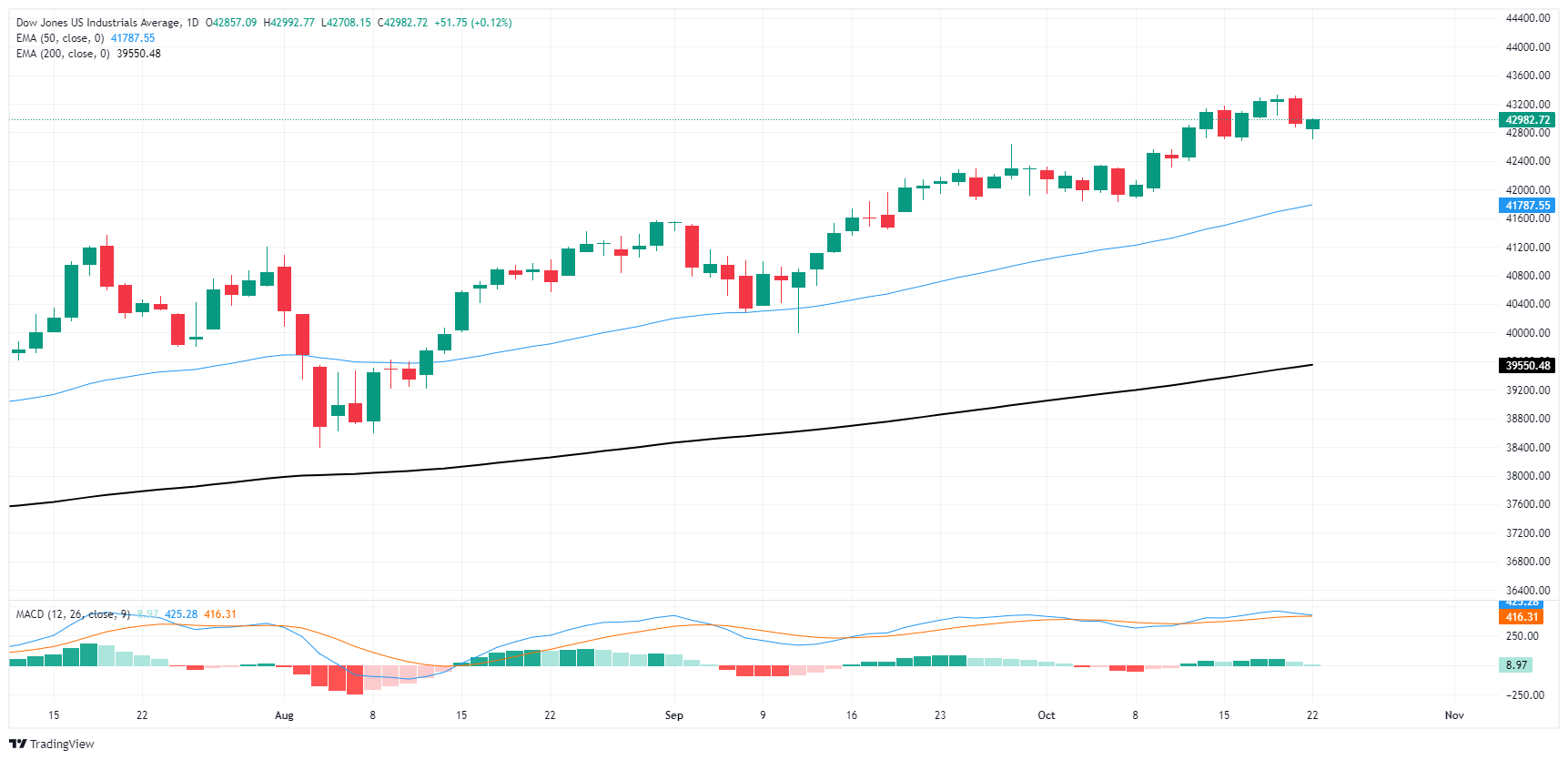- The Dow Jones waffled near the 43,000 handle on Tuesday.
- Equities are grappling with an uptick in yields.
- A lack of confident tone from Fed officials leaves stocks hanging in overbought territory.
The Dow Jones Industrial Average (DJIA) struggled to find its feet near the 43,000 handle on Tuesday. The major index pulling into the midrange as bulls struggled to respond to a near-term decline that kicked off the trading week.
Earnings season is well underway, helping to bolster investor confidence enough to keep losses contained despite equity prices trading deep into overbought territory and most of the market’s favored stocks trading at eye-watering ratios. Equity giants Tesla (TSLA) and Coca-Cola (COKE) will report Q3 earnings on Wednesday, with Honeywell (HON) slated for Thursday.
On Tuesday, General Motors (GM) and Philip Morris (PM) handily beat Wall Street expectations, raising their full-year earnings guidance. Meanwhile, Verizon (VZ) flubbed its latest earnings call, with revenue missing expectations.
Dow Jones news
Despite a cautious start to the day, roughly two-thirds of the Dow Jones are trading into the green on Tuesday. Microsoft (MSFT) rose 2.3% to $428.50 per share, followed by retail giant Walmart (WMT), which gained 1.5% to touch $82 per share. On the low side, Verizon (VZ) crumpled 4.5%, declining below $42 per share after flubbing earnings expectations.
Dow Jones price forecast
Despite a near-term pullback, the Dow Jones remains in a firmly bullish pattern, with the major equity index trading well above its 50-day and 200-day Exponential Moving Averages (EMA) at 41,788 and 39,453, respectively. DJIA prices have been grinding higher since August’s swing low into 38,400, adding nearly 13% bottom-to-top.
The Moving Average Convergence-Divergence (MCAD) is breaking the needle printing in bullish territory, however a contracting histogram is hinting at slowing bullish momentum that has been underpinning the Dow Jones for most of 2024. Despite a deep overbought print on the MACD, potential for downside price action remains limited with the Dow Jones poised for a sixth consecutive month in the green.
Dow Jones daily chart
Dow Jones FAQs
The Dow Jones Industrial Average, one of the oldest stock market indices in the world, is compiled of the 30 most traded stocks in the US. The index is price-weighted rather than weighted by capitalization. It is calculated by summing the prices of the constituent stocks and dividing them by a factor, currently 0.152. The index was founded by Charles Dow, who also founded the Wall Street Journal. In later years it has been criticized for not being broadly representative enough because it only tracks 30 conglomerates, unlike broader indices such as the S&P 500.
Many different factors drive the Dow Jones Industrial Average (DJIA). The aggregate performance of the component companies revealed in quarterly company earnings reports is the main one. US and global macroeconomic data also contributes as it impacts on investor sentiment. The level of interest rates, set by the Federal Reserve (Fed), also influences the DJIA as it affects the cost of credit, on which many corporations are heavily reliant. Therefore, inflation can be a major driver as well as other metrics which impact the Fed decisions.
Dow Theory is a method for identifying the primary trend of the stock market developed by Charles Dow. A key step is to compare the direction of the Dow Jones Industrial Average (DJIA) and the Dow Jones Transportation Average (DJTA) and only follow trends where both are moving in the same direction. Volume is a confirmatory criteria. The theory uses elements of peak and trough analysis. Dow’s theory posits three trend phases: accumulation, when smart money starts buying or selling; public participation, when the wider public joins in; and distribution, when the smart money exits.
There are a number of ways to trade the DJIA. One is to use ETFs which allow investors to trade the DJIA as a single security, rather than having to buy shares in all 30 constituent companies. A leading example is the SPDR Dow Jones Industrial Average ETF (DIA). DJIA futures contracts enable traders to speculate on the future value of the index and Options provide the right, but not the obligation, to buy or sell the index at a predetermined price in the future. Mutual funds enable investors to buy a share of a diversified portfolio of DJIA stocks thus providing exposure to the overall index.
Information on these pages contains forward-looking statements that involve risks and uncertainties. Markets and instruments profiled on this page are for informational purposes only and should not in any way come across as a recommendation to buy or sell in these assets. You should do your own thorough research before making any investment decisions. FXStreet does not in any way guarantee that this information is free from mistakes, errors, or material misstatements. It also does not guarantee that this information is of a timely nature. Investing in Open Markets involves a great deal of risk, including the loss of all or a portion of your investment, as well as emotional distress. All risks, losses and costs associated with investing, including total loss of principal, are your responsibility. The views and opinions expressed in this article are those of the authors and do not necessarily reflect the official policy or position of FXStreet nor its advertisers. The author will not be held responsible for information that is found at the end of links posted on this page.
If not otherwise explicitly mentioned in the body of the article, at the time of writing, the author has no position in any stock mentioned in this article and no business relationship with any company mentioned. The author has not received compensation for writing this article, other than from FXStreet.
FXStreet and the author do not provide personalized recommendations. The author makes no representations as to the accuracy, completeness, or suitability of this information. FXStreet and the author will not be liable for any errors, omissions or any losses, injuries or damages arising from this information and its display or use. Errors and omissions excepted.
The author and FXStreet are not registered investment advisors and nothing in this article is intended to be investment advice.
Recommended content
Editors’ Picks

AUD/USD regains traction toward 0.6300 after RBA Governor Bullock's presser
AUD/USD is marching back toward 0.6300 in Tuesday's Asian trading, capitalizing on RBA Governor Bullock's prudence amid global uncertainties. The Australian central bank warranted caution on the inflation outlook while maintaining the key rate at 4.1% earlier in the session.

Gold price extends bullish trend amid rising trade tensions; fresh record high and counting
Gold price continues to scale new record highs for the fourth straight day on Tuesday. Worries about the widening global trade war and geopolitical risks boost the commodity. Fed rate cut bets weigh on the USD and further benefit the non-yielding yellow metal.

USD/JPY trades on the backfoot below 150.00 amid trade war fears
USD/JPY edges lower in the Asian session on Tuesday as hawkish BoJ expectations continue to offer some support to the Japanese Yen. Subdued US Dollar price action weighs on the pair. Concerns over Trump's tariffs and its impact on the global economic growth remain a drag on the pair.

Ethereum: Short-term holders spark $400 million in realized losses, staking flows surge
Ethereum bounced off the $1,800 support on Monday following increased selling pressure from short-term holders and tensions surrounding President Donald Trump's reciprocal tariff kick-off on April 2.

US: Trump's 'Liberation day' – What to expect?
Trump has so far enacted tariff changes that have lifted the trade-weighted average tariff rate on all US imports by around 5.5-6.0%-points. While re-rerouting of trade will decrease the effectiveness of tariffs over time, the current level is already close to the highest since the second world war.

The Best brokers to trade EUR/USD
SPONSORED Discover the top brokers for trading EUR/USD in 2025. Our list features brokers with competitive spreads, fast execution, and powerful platforms. Whether you're a beginner or an expert, find the right partner to navigate the dynamic Forex market.

